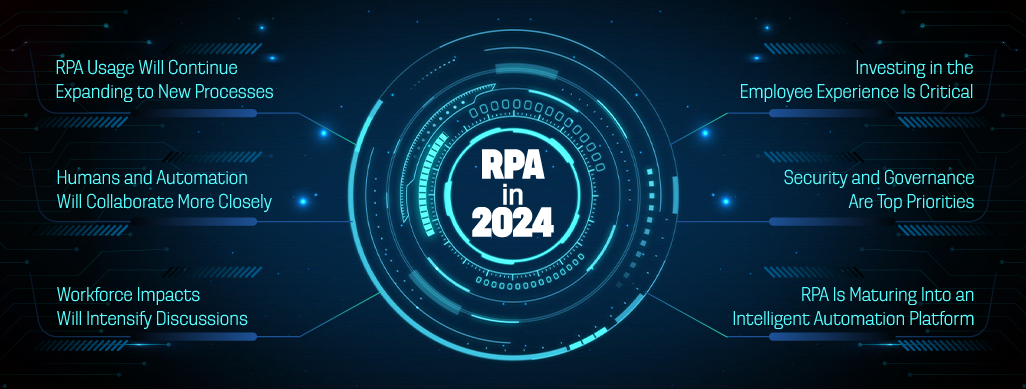
We use cookies to ensure that we give you the best experience on our website.
By using this site, you agree to our use of cookies. Find out more.
In this blog, we will discuss 6 important things for executives to know about Robotic Process Automation in India and how the industry is expected to evolve in 2024.

As we wrap up 2023, Robotic Process Automation (RPA) has increasingly become a fixture for driving digital transformation across organizations in India and worldwide. Leveraging the many Robotic Process Automation Benefits, both mid-sized and large enterprises have turned to RPA to streamline operations, reduce costs, and enhance customer experience.
However, as this technology continues to mature and integrate more advanced capabilities, business leaders must stay abreast of key trends to maximize ROI and remain competitive in the new year. In this blog, we will discuss 6 important things for executives to know about Robotic Process Automation in India and how the industry is expected to evolve in 2024.
Robotic process automation (RPA) involves the use of software robots or artificial intelligence (AI) assistants to handle high-volume, repeatable tasks that previously required humans to perform. RPA bots are able to work 24/7, emulating the actions of a human interacting within unstructured IT environments to execute processes and manipulate data much faster and more accurately than people. By implementing RPA, organizations aim to reduce operating costs by replacing human labor with software for routine tasks while also improving productivity and quality.
RPA bots are designed to process structured data from websites, applications, files and databases exactly as a human would when completing tasks and workflows. They can interact with user interfaces, understand data, make calculations, trigger responses and communicate with other systems all without needing to be programmed for each individual task.
RPA leverages existing technologies to deliver cost savings, increase profitability and help businesses scale simply by adding more bots rather than hiring additional people. Automation handles repetitive, manual processes so employees can focus on more value-added strategic work.
Here are the 6 things to know about robotic process automation:

As organizations in India and worldwide have realized the Robotic Process Automation benefits, its use cases have rapidly proliferated across back-office functions like finance, HR, IT and customer service in the past few years.
Originally used primarily for repetitive, rules-based activities like data entry or invoice processing, RPA is now poised to migrate to new domains that have previously been challenging to automate at scale. The increased intelligence of modern RPA tools allows bots to handle more complex workflows that involve exceptions, unstructured data and non-linear decision trees.
In India especially, sectors like healthcare, retail and manufacturing will deploy RPA more aggressively in 2024 to streamline clinical operations and reshape front-office customer interactions. Bots will integrate with existing systems to automate full end-to-end processes that touch multiple departments, from order orchestration to patient record-keeping.
Industries like telecommunications, media and insurance will leverage RPA in innovative areas such as network fulfillment, content optimization and underwriting support. This expansion will cement the technology's role as a flexible automation backbone that keeps Indian enterprises competitive through higher throughput, lower operating costs and transformed user experiences.
As Robotic Process Automation matures in India, the relationship between human workers and software robots is evolving from one of replacement to partnership. Traditionally, RPA handled basic, rules-driven tasks independently of human input.
However, with advances in technologies like artificial intelligence, process mining and natural language processing, bots are now able to work interactively with people. In many Indian organizations, this blended arrangement is being adopted where employees and bots collaborate seamlessly on shared workloads, with automation taking on standardized activities and humans managing nuanced tasks.
This collaborative model has many benefits for both parties. It allows businesses in India to scale operations beyond what humans alone could manage, while giving employees more strategic work and freeing up time for high-impact activities.
Automation also enhances routine jobs through integrated features like just-in-time suggestions, automatic assignment routing and assistive servicing aids. As knowledge is captured by bots, they become effective advisors that improve worker productivity and decision-making. This evolution of human-robot teaming is set to accelerate in 2024 through further intelligent automation advances within the Robotic Process Automation India.
As Robotic Process Automation delivers greater benefits like accelerated operations and reduced costs for businesses in India and globally, their impacts on job roles and the workforce are receiving increased attention. While RPA generates efficiencies, questions remain around how automation will affect existing employees and transform the nature of work.
Some roles may be displaced while new positions are created to support digital transformation initiatives, requiring employees to continuously upskill. As automation penetrates deeper into both back-office and front-office processes in 2024, these discussions around change management and reskilling will intensify.
For organizations to maximize the Robotic Process Automation benefits long-term, they must proactively manage this change. Companies that actively support their workforce through training programs, career coaching and redeployment services will navigate disruption more smoothly. Early adopters in India are already implementing strategies like dedicated learning portals, internal hackathon initiatives and reskilling stipends, recognizing that an engaged, future-fit workforce is critical for business success in an automated world. As adoption increases, both financial services and manufacturing companies will face growing pressure to implement policies assisting workers impacted by automation.
For organizations in India and worldwide to maximize the Robotic Process Automation benefits, focusing on employee experience should be a top priority in 2024. Automation has the power to transform not just processes but also how people work, interact and progress in their careers.
Companies must design the digital workplace around human needs and ensure systems integrate seamlessly into daily tasks. Investing in employee training portals, collaboration software, blended workflow tools and skills academies can help workers gain proficiency leveraging various automation technologies for maximum productivity and engagement.
Prioritizing the user experience is key to change employee perception from viewing automation as a threat to an enabler. When implemented properly while involving workers, RPA brings benefits like reduced mundane workloads, data-driven decision making, and new opportunities to take on higher value activities.
Indian companies breaking into global markets will recognize that digital skills and comfort with emerging tech are must-haves for the future workforce. Focusing on the employee experience through continual development offerings and automated services supporting their goals will help realizing the full value of Robotic Process Automation investments.
As use of Robotic Process Automation expands exponentially across organizations in India, maintaining robust security and controls will be paramount. Bots increasingly handle sensitive employee records, customer identities, financial transactions and more. Any vulnerability could potentially expose vast amounts of regulated data.
In 2024, companies implementing RPA at scale in India must harden their systems with measures like multi-factor authentication for bot management, rule-based change control protocols, and rigorous monitoring of all automated operations. Segmenting bots and data, restricting physical and cloud access, and training employees on secure practices will be table stakes.
Strong governance is also imperative as more departments deploy automation across their processes. In Robotic Process Automation India, defining standards for deployment management, incident response, regulatory tracking and reporting will provide transparency and accountability. Regular audits ensure continued compliance, while revision controls incorporate new policies seamlessly.
Ensuring bots only perform intended tasks requires detailed change logs, version control and anomaly detection. Leadership must provide resources and oversight so security teams can properly safeguard automated infrastructure and reinforce secure development within this rapidly growing sector in India.
Leading RPA vendors have recognized that to stay relevant, Robotic Process Automation must evolve beyond routine tasks. In India, where RPA adoption is brisk, the technology is maturing to integrate capabilities like computer vision, natural language processing and decisioning engines. Bots are enhancing their skills through machine learning on large volumes of process data. This is enabling them to handle more ambiguity and make educated choices autonomously. As intelligent automation platforms, they can optimize workflows by recommending improvements based on performance analytics.
The converged platform approach allows India's organizations to solve exponentially more complex, multi-step processes. Intelligent RPA understands context and interacts more naturally with users to provide assistance, rather than solely executing pre-defined scripts. This raises the ceiling of what's possible through automation. Leaders in Robotic Process Automation India are leveraging these advanced tools to digitally transform operations at an unbelievable rate. With high-skilled bots supporting knowledge-based work, enterprises can innovate quicker than ever before while developing differentiated customer propositions.
2024 promises to be an important year for the advancement of Robotic Process Automation India and globally. As intelligent capabilities like AI, process mining and analytics become tightly integrated into platforms, the potential for automation to empower organizations and transform industries will reach new heights.
However, navigating changing workforce dynamics, upholding security and compliance, as well as delivering an enriched employee experience through these technologies will be paramount. By understanding emerging priorities and keeping apace of a rapidly developing landscape, business leaders can best position their companies to lead in an automated future and capitalize on all the Robotic Process Automation Benefits it promises.
Leave a Comment
Your email address will not be published.